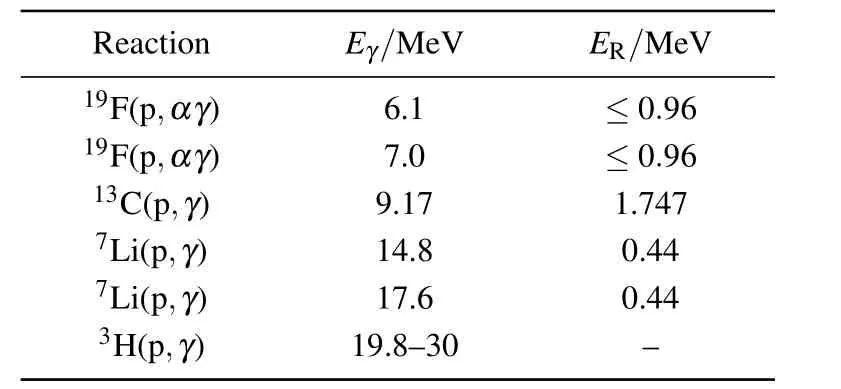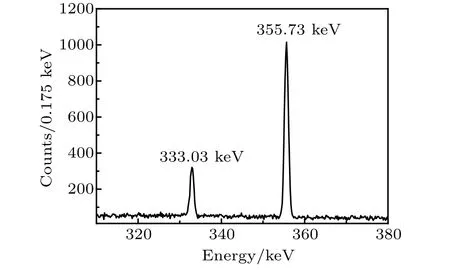Photoactivation experiment of 197Au(γ,n)performed with 9.17-MeV γ-ray from 13C(p,γ)14N∗
Yong-Le Dang(党永乐), Fu-Long Liu(刘伏龙), Guang-Yong Fu(付光永),Di Wu(吴笛), and Nai-Yan Wang(王乃彦),†
1College of Nuclear Science and Technology,Beijing Normal University,Beijing 100875,China
2China Institute of Atomic Energy,Beijing 102413,China
Keywords:resonance reaction,high energy γ-ray,photonuclear reaction
1.Introduction
Development of nuclear power is the strategic choice for solving the energy supply and ensuring the sustainable development of economy and society.However,nuclear reactor of 1-GW power products about 30-tons spent fuel per year,including long-lived fission product(LLFP)about 30 kg.[1]In this situation,the disposal of LLFP becomes much important.The prime ways such as deeply bury,transport to the space,and ice cover are unable to ensure absolute safety which is the fundamental requirement of long-lived radioactive wastes disposal. In 1990s,Accelerator Driven Sub-critical System(ADS)was known as an effective method.[2]For most radioactive wastes,the neutron cross sections are high enough so the coupling efficiencies of transmutation are considerable.However,for some nuclei,the neutron cross section is very low and there may be some new radioactive nuclei generated during the transmutation of137Cs.Another approach,photoneutron transmutation,due to the giant dipole resonance(GDR),may be a supplement of neutron transmutation,in which the largest cross section will be several hundreds millibarn in the high energy range.[3]
The high energy γ-ray is generated mainly by bremsstrahlung,positron annihilation in flight,laser Compton scattering,and nuclear excitation in nuclear reaction.[4]As a standard for studies on photonuclear reactions,197Au(γ,n)has been investigated to verify the ability of transmutation perform with γ-ray.In previous studies,photonuclear experiments were performed mainly by using the γ-ray source of positron annihilation in flight.[5]The photoactivation experiment on197Au was measured with bremsstrahlung facility on ELBE(electron linear accelerator of high brilliance and low emittance).[6]The photoneutron cross section of197Au(γ,n)was measured with laser Compton scattering γ-ray at ring at AIST Tsukuba.[7]The nuclear transmutation rate on197Au was measured on New SUBARU.[8]While the γ-rays from positron annihilation in flight,bremsstrahlung,and laser Compton scattering are not mono-energetic even continuous,so it is necessary to study the cross section or transmutation using mono-energetic γ-ray and compare the result with the measured values obtained with other methods.
Table 1 shows several(p,γ)resonance reactions of light nuclei.In the present work,γ-ray from13C(p,γ)14N reaction at Ep=1.75 MeV has been used to measure the cross sections of197Au(γ,n)at 9.17 MeV,by measuring the γ-ray decay from the reaction product,196Au. For the accuracy of measurement,the depth distribution of196Au in gold target and the attenuation of γ-ray from196Au inside the target have been taken into account.

Table 1.Several resonance reactions.
2.Experiment
According to the previous investigations,the reaction threshold of197Au(γ,n)and197Au(γ,2n)are 8.07 MeV and 14.7 MeV respectively.[9]So for the experiment of irradiation on197Au by 9.17-MeV γ-rays generated from13C(p,γ)14N reaction at Ep=1.75 MeV,only197Au(γ,n)reaction can be taken place. There are two methods in measuring this reaction rate,i.e.,by measuring neutrons during the reaction and by measuring γ-rays following the product.Considering the count rate of detector and the background during the irradiation,we decide to measure the γ-rays decay after the irradiation.
As the product of197Au(γ,n)reaction,the unstable nucleus196Au will decay to196Pt(T1/2=6.18 d)by EC+β+or to196Hg by β−.Several main γ-rays during the decay of196Au and their emission probabilities are shown in Table 2.We can see,for the most part,196Au will decay to196Pt with the emission of 355.73-keV γ-rays which can be detected and used to determine the number of196Au nuclei.

Table 2.Several γ-rays during the decay of 196Au and their emission probabilities.
In previous experiment about13C(p,γ)14N at the 2×1.7-MV tandem accelerator in China Institute of Atomic Energy(CIAE),we had already determined the thick target yield and angular distribution of 9.17-MeV γ-ray.[10]The experimental setup of photoactivation experiment is shown in Fig.1.

Fig.1.Experimental setup.
Before the experiment,we should estimate the reaction rate for this experiment,so the thickness of gold target had to be chosen.Because of the attenuation of 355.73-keV γ-rays in the target,it makes no sense to set a very thick target.We estimated the activities after 1-hour irradiation,in which the yield of 9.17-MeV γ-rays was used 4.7×10−9γ/proton in 4π,and the proton beam was 8µA and the thicknesses of targets were changed from 0.05 cm to 2 cm.The estimation result is shown in Fig.2.The value of cross section of197Au(γ,n)we used in calculations is 50 mb.[9]In Fig.2,the activity is going to be saturated when the thickness reaches to 1 cm.However,there is also attenuation for decaying γ-rays in the target,so the thickness should be chosen as thin as possible. By considering those reasons,we finally chose the target thickness as 0.2 cm.

Fig.2.Calculation of the activities of targets with different thicknesses after 1-hour irradiation.
In the experiment,the 8-µA proton beam was directed onto an isotopically pure13C target with 100-µg/cm2thickness,which was evaporated on a gold disk in size φ10×2 mm and cooled with air. There was a collimation to make sure that protons should be bombarded at the center of the target.The coaxial HPGe detector(GXM35P4-70,Ortec)was placed at 69-cm distance from the target and positioned at 0◦,it was used to monitor the yield of γ-rays in order to calculate the number of γ-rays which was irradiated on the197Au target.Two197Au targets had been irradiated for 6 h and 5.5 h respectively.To avoid the impact of decay from short-lived nuclei generated during the bombardment,the targets had been shelved for about 3 h.By a rough estimation,the count rate of 355.73-keV γ-rays will no more than 100-per hour. The number of γ-rays from activated nuclei produced during the activation was determined offline with a low-background and anti-Compton HPGe detector with 105%relative efficiency at CIAE.The full-energy background count rate of this detection system is about 0.1 per second.The γ-ray source133Ba was used to calibrate the absolute efficiency of low-background and anti-Compton HPGe detector system.
There exists absorption when γ-rays traversing through the gold target. The attenuation must be taken into account when measuring the number of 9.17-MeV γ-rays. We set a LaBr3crystal detector in φ3×3 inch(1 inch=2.54 cm)at back direction of proton beam at 85-cm distance from the target and positioned at 125◦. Before the irradiation,the13C target was evaporated on a thin Ta disk in order to normalizing these two detectors.By comparing the count rate of two detectors when the gold target was placed,the attenuation could be determined.It is not only necessary for measuring the number of γ-rays but also important for determining the total cross section of 9.17-MeV γ-rays in the gold target.
3.Data analysis and result
To gain the high statistics,two gold targets were irradiated by γ-rays for 21600 s and 19800 s,shelved for 12900 s and 11040 s respectively.We determine the cross section of197Au(γ,n)by measureing 355.73-keV γ-rays from the product of196Au.Figure 3 shows the spectrum of γ-rays emitted from196Au after irradiation of197Au.

Fig.3. Spectrum of γ-rays emitted from 196Au after irradiation of 197Au using low-background and anti-Compton HPGe detector system for about 4 days.The 333.03-keV and 355.73-keV lines are marked which both decayed from 196Au.
The absolute full-energy-peak detecting efficiency of HPGe detector for γ-ray of 355.73 keV was determined by measuring the 356.01-keV γ-ray decay from133Ba source with the radioactivity of 1.07×105Bq and the emission probability of 356.01-keV γ-ray is 0.621. Considering the emission probability of 355.73 keV from196Au,we got the detecting efficiency,ε=(2.379±0.003)×10−2.
Our experimental setup is shown in Fig.4,the travelling distances are different when 9.17-MeV γ-rays injecting from different angles.

Fig.4.Target setup.
The total number of target nuclei in unit area Nsalong θ direction can be written as

where h and r are the thickness and radius of the gold target,respectively,NAis the Avogadro constant,θ0=arctan(r/h).Thus the photoneutron reaction rate in ∆Ω can be written as

where I(θ)=I(θdet)W(θ)/W(θdet)is the flux of 9.17 MeV in unit solid angle at θ,in which θdetis degree where the detector was established,W(θ)is the angular distribution of 9.17-MeV γ-rays which has been measured in our previous work,[10]and σgis the photoneutron cross section,σtis the total absorption cross section.The term(1 −e−Ns(θ)σg)is the probability of photoneutron reaction.By integrate Eq.(2),the photoneutron reaction rate can be written as

Set t as the irradiated time,t1as the shelved time,t2as the detecting time.The number of196Au nuclei after t and number of196Au decay during t2will respectively be,

Actually,the absorption of 355.73-keV γ-rays in gold target should be taken into account when determining the efficiency. And it is easy to see that the depth distribution of196Au at axial direction in gold target is not uniform.So the attenuation coefficients of 355.73-keV γ-rays in different depths of the target are different.As the photoneutron reaction rate in different depths of the target can indicate the relative depth distribution of196Au at axial direction,we can change the thickness of gold target and calculate the total attenuation coefficient.The total attenuation coefficient can be written as

where σis the total absorption cross section of 355.73-keV γ-ray in gold,whose value is 87.89 b referred from Photon Cross Sections Database,NIST.Thus the absolute efficiency of 355.73-keV γ-ray by considering the absorption in gold target is determined as follows:

So the counts of 355.73-keV γ-rays detected in HPGe will be

Finally,the efficiency was obtained to be ε=(1.741±0.002)×10−2.The total absorption cross section σtwas determined by measured the attenuation of 9.17-MeV γ-ray in gold target with the following equation:

Thus the value of σtwas obtained to be 17.37±2.61 b.
According to Eq.(3)and Eq.(8),the cross section of197Au(γ,n)at 9.17 MeV will be written as

where

According to the equation above,the cross section of197Au(γ,n)at 9.17 MeV can be obtained,and the results and uncertainties from two targets were shown in Table 3.
Table 3.Cross section of 197Au(γ,n)at 9.17 MeV along with the statistical()and systematic()uncertainties.

Table 3.Cross section of 197Au(γ,n)at 9.17 MeV along with the statistical()and systematic()uncertainties.
Sample Ndet NReaction σg/mb ∆σgs tat/mb ∆σgsy st/mb 1 1566±49 1.01±0.03×106 40.1±6.9 6.27 0.63 2 6610±100 1.09±0.02×106 40.4±6.9 6.27 0.63
4.Summary
The measurement of photoneutron cross section is important for studying the abilities of photonuclear transmutation in nuclear wastes disposal.We came up with a new method for measuring the cross section of photoneutron reaction based on a mono-energetic γ-ray source from(p,γ)reaction.We determined the cross section of197Au(γ,n)at 9.17 MeV by using of γ-rays from13C(p,γ)14N reaction.The value obtained was σg=40.3±6.9 mb.We compared our results with the values 48.34±2.13 mb and 45±5 mb obtained by Osamu ITOH[9]and A.VEYSSIERE[11]respectively.
Acknowledgments
One of the authors(Dang)is grateful to professors Chuang-Ye He and Bing Guo for the guide on experiment.The author would like to give sincere gratitude to Mr.Diao for equipment supply of low-background and anti-Compton HPGe detector system.I wish to thank Dr.Qi-Wen Fan for making the target.I would like to give sincere gratitude to the staff in 2×1.7-MV tandem accelerator laboratory at China Institute of Atomic Energy for support in experiment.
- Chinese Physics B的其它文章
- Compact finite difference schemes for the backward fractional Feynman–Kac equation with fractional substantial derivative*
- Exact solutions of a(2+1)-dimensional extended shallow water wave equation∗
- Lump-type solutions of a generalized Kadomtsev–Petviashvili equation in(3+1)-dimensions∗
- Time evolution of angular momentum coherent state derived by virtue of entangled state representation and a new binomial theorem∗
- Boundary states for entanglement robustness under dephasing and bit flip channels*
- Manipulating transition of a two-component Bose–Einstein condensate with a weak δ-shaped laser∗

